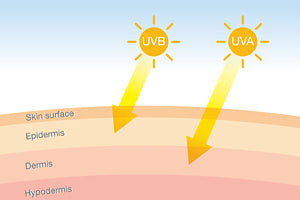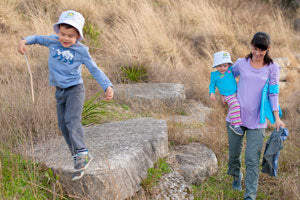Difference Between UVA & UVB
Posted on 30 November 2017

Our understanding of exactly what kinds of damage each causes to the skin, and how best to protect ourselves, seems to shift as new research comes out.
The sunlight that reaches us is made up of two types of harmful rays: long wave ultraviolet A (UVA) and short wave ultraviolet B (UVB). UVA rays penetrate deep into the dermis, the skin’s thickest layer.
Both UVA and UVB play an important role in conditions such as premature skin aging, eye damage (including cataracts), and skin cancers. They also suppress the immune system, reducing your ability to fight off illness.

UVA and UVB
There are three main types of UV rays: UVA, UVB, and UVC. UVC rays are not significant because they do not penetrate our atmosphere.
UVA rays account for up to 95 percent of the UV radiation reaching the Earth's surface. Although they are less intense than UVB, UVA rays are 30 to 50 times more prevalent. They are present with relatively equal intensity during all daylight hours throughout the year, and can penetrate clouds and glass. UVA rays penetrate the skin more deeply than UVB and have been known to play a major part in skin aging and wrinkling.
Studies over the past two decades now show that UVA damages skin cells called keratinocytes in the basal layer of the epidermis, where most skin cancers occur. UVA rays contribute to and may even initiate the development of skin cancers.
UVB rays are the sun’s ultraviolet B short-wave rays. They are the main cause of skin reddening and sunburn. They tend to damage the skin’s more superficial epidermal layers. They play a key role in the development of skin cancer, and they contribute to tanning and wrinkling. Its intensity varies by season, location, and time of day, however, the most significant amount of UVB rays hit the United States between 10 am and 4 pm from April to October.
However, UVB rays can burn and damage your skin year-round, especially at high altitudes and on reflective surfaces like snow or ice. Snow or ice will bounce back up to 80% of the rays; meaning that they hit your skin twice.

SKIN CANCER PREVENTION
It is essential that you protect your skin from UV radiation, both indoors and outside.
When outdoors, seek shade between 10am and 4pm. Wear sun protective clothing-Little Leaves blocks 98% percent of all UV rays, and is more convenient than reapplying sunscreen every 2 hours. Broad-brimmed hats and UV-blocking sunglasses will help shield the sensitive skin on your head, neck, and around the eyes.
Be sure to apply a sunscreen of 30 SPF or higher to the areas of your body that are still exposed. Look for the phrases multi spectrum, broad spectrum or UVA/UVB protection on sunscreen labels.
Sources and Resources:
MoleSafe
Skin Cancer Foundation- UVA & UVB


0 comments